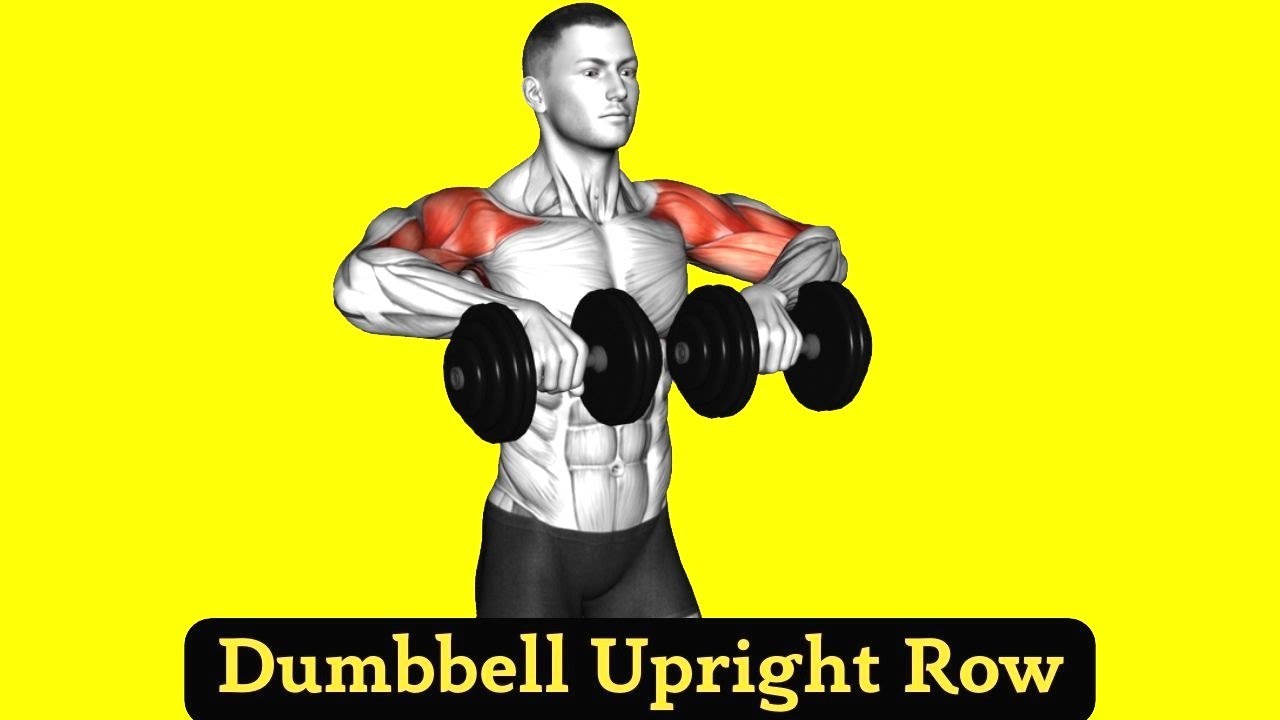The dumbbell upright row is a compound exercise that targets the deltoids (shoulders), traps (upper back), and biceps.
It is one of the best exercises for building stronger and bigger traps and rear deltoids, but it is easy to get wrong. As a result, you will miss the muscle-building benefits of this move and hurt your shoulders.
But you shouldn’t be afraid.
Here, we’ll examine several ways to improve your technique of the dumbbell upright row exercises safely and well.
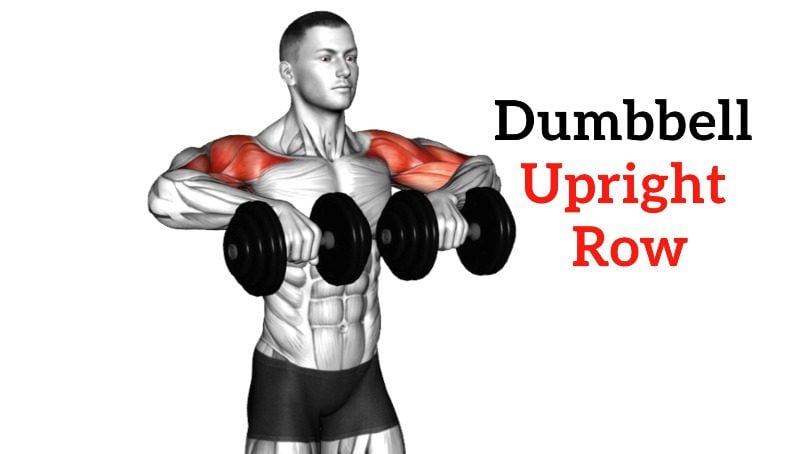
- What Is a Dumbbell Upright Row?
- Dumbbell Upright Row Muscles Worked
- How To Do Upright Dumbbell Row
- How To Do One-Arm Dumbbell Upright Row
- The Correct Technique for Doing Dumbbell Upright Rows
- 1. Make Sure Your Hands Aren’t Too Close Together
- 2. Avoid Lifting Too Much Weight
- 3. Don’t Pull The Bar Too High
- 4. Brace Your Core And Keep Your Torso Upright
- 5. Don’t Roll Shoulder Forward
- 6. Add the Optimum No. Of Sets And Reps.
- 7. During Your Shoulder And Upper Body Workout
- 8. Do Dumbbell Upright Row During Shoulder Workout
- 9. Add Them With Pull Workout Split
- FAQ
- Are upright rows better with dumbbells?
- Is dumbbell upright row good?
- What’s better, a dumbbell or a barbell upright row?
- References
What Is a Dumbbell Upright Row?
It’s a simple exercise. You hold a dumbbell in each hand and lift it vertically, bringing it up to the level of your collarbone before smoothly lowering it back down to the starting position.
Most people do this exercise standing up, but you can also do it sitting down.
The standing DB upright row can be done with different grip widths.
- Close or narrow grip (half of the shoulder width),
- A standard grip (shoulder-width grip)
- A wide grip (wider than the shoulder)
All variations have their unique advantages and disadvantages. Let’s take a closer look at each of these variations:
- The normal grip provides overall shoulder development and suits those seeking balanced muscle activation.
- The narrow grip upright rows emphasize the upper trap more and slightly less on the lateral and rear delt.
- The wide grip emphasizes the lateral and rear deltoid more, and the upper and middle trap slightly less.
Dumbbell Upright Row Muscles Worked
The DB upright row is a compound exercise that targets a muscle group of the upper body.
- The muscles that work primarily during the dumbbell upright row are the deltoid muscles (specifically the front and lateral deltoid) and the trapezius muscles.
- The secondary muscles worked are the biceps and brachialis.
- It also activates the forearms, Rhomboids, and Core muscles for stabilization and support.
It helps to improve shoulder mobility, strength, and upper body power.
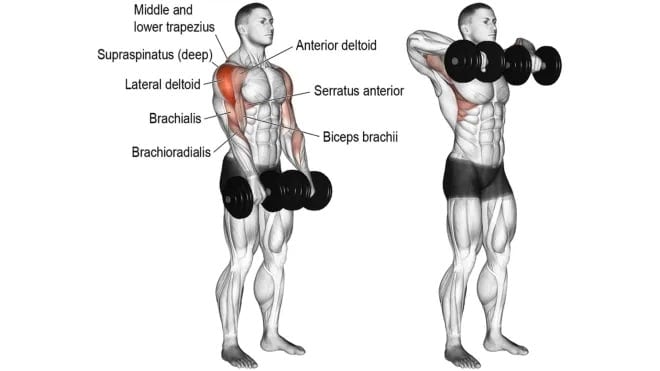
How To Do Upright Dumbbell Row
- Stand with your feet shoulder-width apart, maintaining a straight posture.
- Hold a dumbbell in each hand with an overhand grip (palms facing your body).
- Allow your arms to hang straight down in front of your thighs. Keep your elbows bent.
- While exhaling, lift the dumbbells by pulling them straight towards your chest.
- Keep your elbows close to your body throughout the movement.
- Aim to bring the dumbbells up to the level of your collarbone, just below your chin.
- Focus on using your shoulder muscles to perform the lifting motion.
- Squeeze your shoulder blades together at the top of the movement.
- Inhale as you slowly lower the dumbbells back down to the starting position.
- Now, lower the dumbbell under controlled motion until it returns to its starting position.
- Repeat for the desired number of reps. Aim to perform 8 to 12 reps.
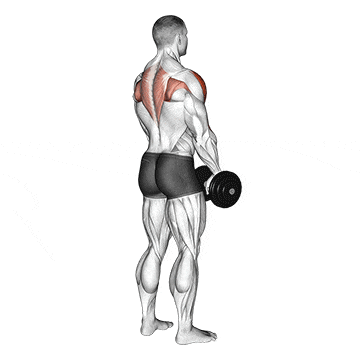
How To Do One-Arm Dumbbell Upright Row
If you want to add variety and challenge to your upper back workout routine, the one-arm dumbbell upright row is a fantastic exercise.
This unilateral variation targets the same muscles while adding an extra element of stability and core engagement.
Focusing on one arm at a time can help you get more muscular, separate specific muscles, and even fix weak spots.
- Stand with your feet shoulder-width apart.
- Hold a dumbbell in your left hand at your side.
- Slowly shrug your left shoulder up toward your ear.
- At the top, pause for a moment and contract the muscles.
- Slowly lower the weight back to the starting position.
- Repeat on the right side after completing all reps on the left side.
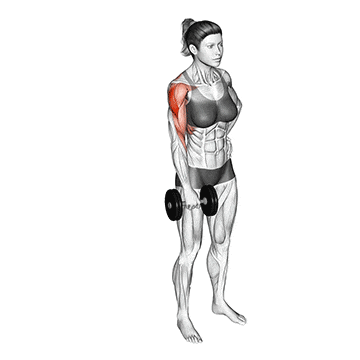
The Correct Technique for Doing Dumbbell Upright Rows
We will teach you how to do an upright row correctly with form and techniques that best avoid shoulder pain and injury.
This allows you to take advantage of this great delt and upper trap isolation exercise.
1. Make Sure Your Hands Aren’t Too Close Together
If you place your hands too close together, it can increase the amount of ulnar deviation (how much your wrist must bend to the side).
This can lead to injury at the wrist, and you can easily avoid it by moving your grip width to be a little wider so that it is more comfortable for you as you lift.
2. Avoid Lifting Too Much Weight
One of the most common mistakes people make when performing the upright row is using too much weight. This approach may place undue strain on your shoulders and increase your risk of injury.
To avoid this, start with a lighter weight and focus on maintaining proper form and technique.
Choose a dumbbell or weight that allows you a nice, slow, and controlled movement.
3. Don’t Pull The Bar Too High
Pulling the dumbbell too high can compress the acromioclavicular joint, increasing the likelihood of an impingement injury at the shoulder.
Controlling the movement and limiting your elbows to reach the same height as your shoulders ensure you are not exerting your shoulder and potentially causing an injury
4. Brace Your Core And Keep Your Torso Upright
As with any lift, maintaining a strong and stable core throughout the lift will aid with bracing and thus protect the spine.
Regarding upright rows, this will also help reduce or prevent swinging the weight away from your center of mass.
5. Don’t Roll Shoulder Forward
When lowering the weight, ensure your chest is proud and your shoulders are pulled back/together (known as scapular retraction).
Retracting your scapulae will put your shoulders in a strong position to lift and help focus the exercise on the deltoid.
6. Add the Optimum No. Of Sets And Reps.
A good starting point is to perform 3–4 sets of 8–12 reps. However, you can adjust the number of sets and reps according to your capability and goals.
Do sets of 10 to 15 reps with moderate weight. If you can perform more than 20 reps with ease, the weight is too light. For best results, try to perform perfect reps to complete failure, with no more than 15 reps per set.
7. During Your Shoulder And Upper Body Workout
It can be included in your shoulder workout routine alongside other exercises such as overhead press, lateral raise, and front raise.
You can perform an upright row as part of an upper body or during a push-pull leg Workout Split.
8. Do Dumbbell Upright Row During Shoulder Workout
| S.NO | Exercise | Sets | Reps |
|---|---|---|---|
| 1 | Seated Dumbbell Shoulder Press | 3-4 | 8-12 |
| 2 | Standing Dumbbell Lateral Raise | 3-4 | 10-15 |
| 3 | Dumbbell Shrug | 3 | 10-12 |
| 4 | Front Plate Raise | 3 | 12-15 |
| 5 | Dumbbell Upright Row | 3 | 10-12 |
9. Add Them With Pull Workout Split
| S.NO | Exercise | Sets | Reps |
|---|---|---|---|
| 1 | Pull-Ups | 3-4 | 8-10 |
| 2 | Bent Over Barbell Rows | 3-4 | 8-10 |
| 3 | Dumbbell Upright Row | 3 | 10-12 |
| 4 | Bicep Curls (with dumbbells or barbell) | 3 | 12-15 |
| 5 | Hammer Curls | 3 | 10-12 |
| 6 | Barbell Shrug | 3 | 12-15 |
FAQ
Are upright rows better with dumbbells?
Yes, doing an upright row with dumbbells. Dumbbell requires more balance than barbells or machines, which can lead to greater muscle fiber recruitment.
Dumbbell upright rows workouts allow unilateral training (training one limb at a time), increase core stability, and improve muscular imbalances.
Is dumbbell upright row good?
Dumbbell upright rows are a good upper-body exercise designed to work for muscle groups throughout your arms, shoulders, and upper back. One of the main things about these exercises is that they are shoulder-friendly.
What’s better, a dumbbell or a barbell upright row?
Both the dumbbell and barbell upright row have advantages. Barbell upright row exercises provide versatility and can help you strengthen virtually every muscle in the body with a wider range of resistance.
On the other hand, barbells are large, cumbersome, and generally awkward to move around with. Dumbbells don’t have either of those limitations and allow for free-range on any plane of motion.
References
- Schoenfeld, Brad MSc, CSCS; Kolber, Morey J PT, PhD, CSCS; Haimes, Jonathan E BS, CSCS: The Upright Row: Implications for Preventing Subacromial Impingement. Strength and Conditioning Journal: October 2011 – Volume 33 – Issue 5 – p 25-28
- Ronai, Peter MS, CSCS, RCEP: Exercise Modifications and Strategies to Enhance Shoulder Function. Strength and Conditioning Journal: August 2005 – Volume 27 – Issue 4 – p 36-45
- Cools AM, Witvrouw EE, Declercq GA, Danneels LA, Cambier DC. Scapular muscle recruitment patterns: Trapezius muscle latency with and without impingement symptoms. Am J Sports Med 31: 542–549, 2003.
- Int J Environ Res Public Health. Trapezius muscle timing during selected shoulder rehabilitation exercises. 2021 Jun 14;18(12):6444. doi: 10.3390/ijerph18126444.PMID: 34198674
- Lorenzetti S, Dayer R, Pluss M, List R. Pulling exercises for strength training and rehabilitation: movements and loading conditions. J Funct Morphol Kinesiol. 2017;2(3):33. doi:10.3390/jfmk2030033

Manish is a NASM-certified fitness and nutrition coach with over 10 years of experience in weight lifting and fat loss fitness coaching. He specializes in gym-based training and has a lot of knowledge about exercise, lifting technique, biomechanics, and more.
Through “Fit Life Regime,” he generously shares the insights he’s gained over a decade in the field. His goal is to equip others with the knowledge to start their own fitness journey.

